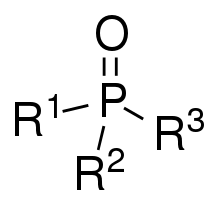Phosphine oxide
Phosphine oxides are phosphorus compounds with the formula OPX3. When X = alkyl or aryl, these are organophosphine oxides. Triphenylphosphine oxide is an example. An inorganic phosphine oxide is phosphoryl chloride (POCl3). Such compounds are thermally stable, decomposing only above 450 °C.[1] Phosphoryl refers to a functional group drawn with a phosphorus-oxygen double bond.

Structure and bonding
Phosphine oxides feature tetrahedral phosphorus centers. The P-O bond is short and polar. According to molecular orbital theory, the short P–O bond is attributed to the donation of the lone pair electrons from oxygen p-orbitals to the antibonding phosphorus-carbon bonds; This proposal, which is supported by ab initio calculations, has gained consensus in the chemistry community.[2]
The nature of the P–O bond was once hotly debated. Some discussions invoked a role for phosphorus-centered d-orbitals in bonding, but this analysis is not supported by computational analyses. In terms of simple Lewis structure, the bond is more accurately represented as a dative bond, as is currently used to depict an amine oxide.
Syntheses
Phosphine oxides are generated as a by-product of the Wittig reaction:
- R3PCR'2 + R"2CO → R3PO + R'2C=CR"2
Another route to phosphine oxides is the thermolysis of phosphonium hydroxides:
- [PPh4]Cl + NaOH → Ph3PO + NaCl + PhH
In the laboratory, phosphine oxides are usually generated by the oxidation, often accidentally, of tertiary phosphines:
- R3P + 1/2 O2 → R3PO
Basic phosphines, such as trialkyl derivatives, are prone to this reaction.
The hydrolysis of phosphorus(V) dihalides also affords the oxide:[3]
- R3PCl2 + H2O → R3PO + 2 HCl
A special nonoxidative route is applicable secondary phosphine oxides, which arise by the hydrolysis of the chlorophosphine. An example is the hydrolysis of chlorodiphenylphosphine to give diphenylphosphine oxide:
- Ph2PCl + H2O → Ph2P(O)H + HCl
Deoxygenation
The deoxygenation of phosphine oxides has been extensively developed.[4] Trichlorosilane is a standard laboratory method. Industrial routes use phosgene or equivalent reagents, which produce chlorotriphenylphosphonium chloride, which is separately reduced.[5]
For chiral phosphine oxides, deoxygenation can proceed with retention or inversion of configuration. Classically, inversion is favored by a combination of trichlorosilane and triethylamine whereas in the absence of the Lewis base, the reaction proceeds with retention.[6]
- HSiCl3 + Et3N ⇋ −SiCl3 + Et3N+H
- R3PO + Et3NH+ ⇋ R3P+OH + Et3N
- −SiCl3 + R3P + OH → PR3 + HOSiCl3
The popularity of this method is partly attributable to the availability of inexpensive trichlorosilane. Instead of HSiCl3, other perchloropolysilanes, e.g. hexachlorodisilane (Si2Cl6), can also be used. In comparison, using the reaction of the corresponding phosphine oxides with perchloropolysilanes such as Si2Cl6 or Si3Cl8 in benzene or chloroform, phosphines can be prepared in higher yields.
- R3PO + Si2Cl6 → R3P + Si2OCl6
- 2 R3PO + Si3Cl8 → 2 R3P + Si3O2Cl8
Deoxygenation has been effected with boranes and alanes.[4]
Use
Phosphine oxides are ligands in various applications of homogeneous catalysis. In coordination chemistry, they are known to have labilizing effects to CO ligands cis to it in organometallic reactions. The cis effect describes this process.
Parent compound
The parent compound phosphine oxide (H3PO) is unstable. It has been detected with mass spectrometry as a reaction product of oxygen and phosphine,[7] by means of FT-IR in a phosphine-ozone reaction[8] and in matrix isolation with a reaction of phosphine, vanadium oxytrichloride and chromyl chloride.[9] It has also been reported relatively stable in a water-ethanol solution by electrochemical oxidation of white phosphorus, where it slowly disproportionates into phosphine and hypophosphorous acid.[10] Secondary phosphine oxides (R2P(O)H) are tautomers of phosphinous acids (R2POH).

Phosphine oxide is reported as an intermediate in the room-temperature polymerization of phosphine and nitric oxide to solid PxHy.[11]
References
- D. E. C. Corbridge "Phosphorus: An Outline of its Chemistry, Biochemistry, and Technology" 5th Edition Elsevier: Amsterdam 1995. ISBN 0-444-89307-5.
- D. B. Chesnut (1999). "The Electron Localization Function (ELF) Description of the PO Bond in Phosphine Oxide". Journal of the American Chemical Society. 121 (10): 2335–2336. doi:10.1021/ja984314m.
- W. B. McCormack (1973). "3-Methyl-1-Phenylphospholene oxide". Organic Syntheses.; Collective Volume, 5, p. 787
- Podyacheva, Evgeniya; Kuchuk, Ekaterina; Chusov, Denis (2019). "Reduction of phosphine oxides to phosphines". Tetrahedron Letters. 60 (8): 575–582. doi:10.1016/j.tetlet.2018.12.070.
- van Kalkeren, H. A.; van Delft, F. L.; Rutjes, F. P. J. T. (2013). "Organophosphorus Catalysis to Bypass Phosphine Oxide Waste". ChemSusChem. 6 (9): 1615–1624. doi:10.1002/cssc.201300368. PMID 24039197.CS1 maint: multiple names: authors list (link)
- Klaus Naumann; Gerald Zon; Kurt Mislow (1969). "Use of hexachlorodisilane as a reducing agent. Stereospecific deoxygenation of acyclic phosphine oxides". Journal of the American Chemical Society. 91 (25): 7012–7023. doi:10.1021/ja01053a021.
- Hamilton, Peter A.; Murrells, Timothy P. (1985). "Kinetics and mechanism of the reactions of PH3 with O(3P) and N(4S) atoms". J. Chem. Soc., Faraday Trans. 2 (81): 1531–1541. doi:10.1039/F29858101531.
- Withnall, Robert; Andrews, Lester (1987). "FTIR spectra of the photolysis products of the phosphine-ozone complex in solid argon". J. Phys. Chem. 91 (4): 784–797. doi:10.1021/j100288a008.
- Kayser, David A.; Ault, Bruce S. (2003). "Matrix Isolation and Theoretical Study of the Photochemical Reaction of PH3 with OVCl3 and CrCl2O2". J. Phys. Chem. A. 107 (33): 6500–6505. Bibcode:2003JPCA..107.6500K. doi:10.1021/jp022692e.
- Yakhvarov, D.; Caporali, M.; Gonsalvi, L.; Latypov, S.; Mirabello, V.; Rizvanov, I.; Sinyashin, O.; Stoppioni, P.; Peruzzini, M. (2011). "Experimental Evidence of Phosphine Oxide Generation in Solution and Trapping by Ruthenium Complexes". Angewandte Chemie International Edition. 50: 5370–5373. doi:10.1002/anie.201100822. PMID 21538749.
- Zhao, Yi-Lei; Flora, Jason W.; David Thweatt, William; Garrison, Stephen L.; Gonzalez, Carlos; Houk, K. N.; Marquez, Manuel (2009). "Phosphine Polymerization by Nitric Oxide: Experimental Characterization and Theoretical Predictions of Mechanism". Inorg. Chem. 48 (3): 1223–1231. doi:10.1021/ic801917a.